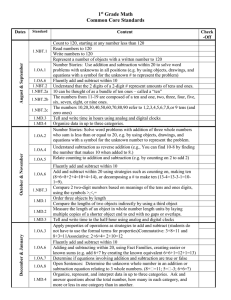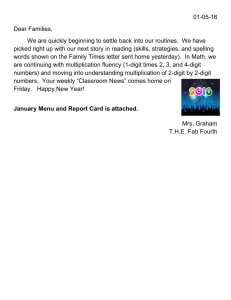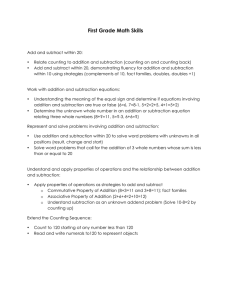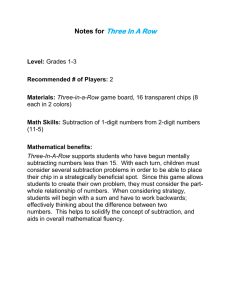First Grade Math I Can Statements Common Core Standards 1.OA.1
advertisement
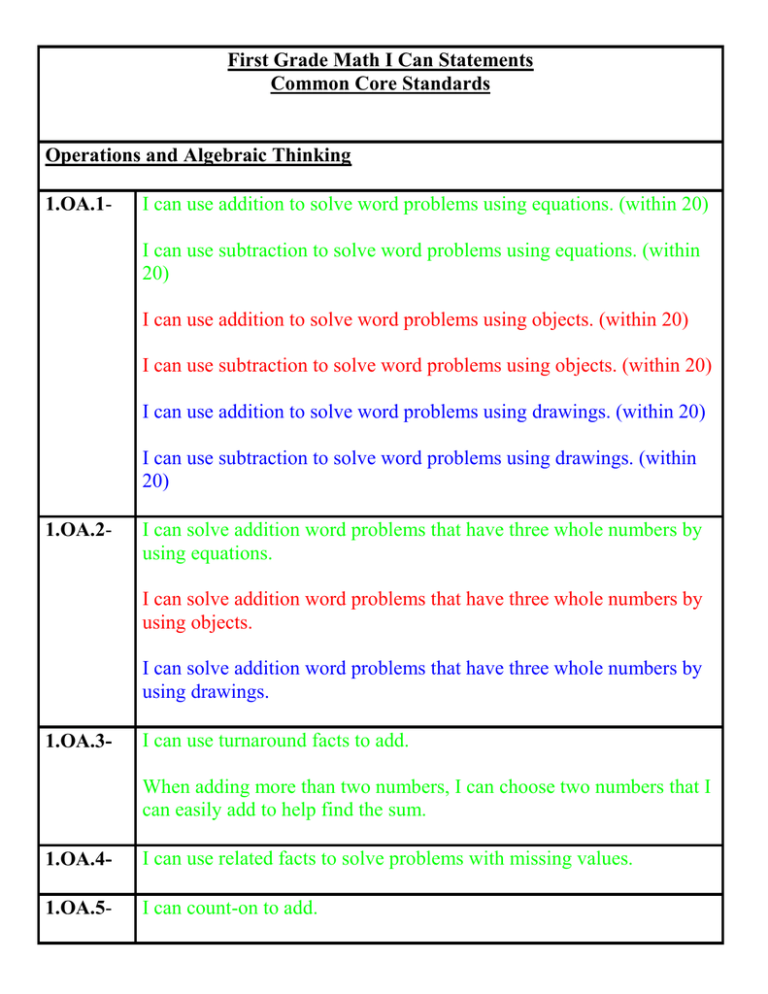
First Grade Math I Can Statements Common Core Standards Operations and Algebraic Thinking 1.OA.1- I can use addition to solve word problems using equations. (within 20) I can use subtraction to solve word problems using equations. (within 20) I can use addition to solve word problems using objects. (within 20) I can use subtraction to solve word problems using objects. (within 20) I can use addition to solve word problems using drawings. (within 20) I can use subtraction to solve word problems using drawings. (within 20) 1.OA.2- I can solve addition word problems that have three whole numbers by using equations. I can solve addition word problems that have three whole numbers by using objects. I can solve addition word problems that have three whole numbers by using drawings. 1.OA.3- I can use turnaround facts to add. When adding more than two numbers, I can choose two numbers that I can easily add to help find the sum. 1.OA.4- I can use related facts to solve problems with missing values. 1.OA.5- I can count-on to add. I can count back to subtract. I can count up to subtract. 1.OA.6- I can fluently add by memory. (within 10) I can fluently subtract by memory. (within 10) I can fluently add using strategies. (within 20) I can fluently subtract using strategies. (within 20) 1.OA.7- I know what an equal sign means. I can determine if an addition equation is true or false. I can determine if a subtraction equation is true or false. 1.OA.8- I can determine the missing value in an addition equation. I can determine the missing value in a subtraction equation. Number and Operations in Base Ten 1.NBT.1- I can write the number for a given number of objects to 120. I can count to 120. I can count to 120 starting at any number less than 120. I can read numbers to 120. I can write numbers to 120. 1.NBT.2- I know that a bundle of ten ones is called a ten. I can identify how many tens are in a 2-digit number. I can identify how many ones are in a 2-digit number. I can identify the number of tens and ones in a numbers that are multiples of ten. I can write any 2-digit number in expanded form. 1.NBT.3- I can identify the number that is greater using tens and ones. I can identify the number that is less using tens and ones. I can compare two 2-digit numbers to determine if a number is equal using the tens and ones. I can use the symbols >, <, and = to compare two 2-digit numbers. 1.NBT.4- I can add a 2-digit number and a 1-digit number. I can add a 2-digit number and a multiple of ten. I can explain what strategy I used to solve my problem. I can determine when to regroup in an addition problem. I can explain the steps I used to solve my problem. I can add two 2-digit numbers without regrouping. I can add two 2-digit numbers with regrouping. 1.NBT.5- I can find 10 more than a number without having to count. I can find 10 less than a number without having to count. I can explain how to find 10 more than a number. I can explain how to find 10 less than a number. 1.NBT.6- I can subtract a multiple of 10 from another multiple of 10. (10-90) I can explain the strategy I use to solve my problem. Measurement and Data 1.MD.1- I can order objects by length. I can use one object to help me describe the length of other objects. 1.MD.2- I can measure an object using nonstandard units. 1.MD.3- I can recognize the hour hand. I can recognize the minute hand. I can tell time to the hour using a digital clock. I can tell time to the half-hour using a digital clock. I can tell time to the hour using an analog clock. I can tell time to the half-hour using an analog clock. I can write the time in hours. I can write the time in half-hours. 1.MD.4- I can organize data with up to three categories. I can interpret a graph by asking questions about the data. I can interpret a graph by answering questions about the data. I can interpret a graph by comparing how many more are in one category than another. I can interpret a graph by comparing how many less are in one category than another. Geometry 1.G.1- I can distinguish between attributes that define the shape and attributes that do not define the shape. I can use attributes to build shapes. I can use attributes to draw shapes. 1.G.2- I can build a new shape using two 2-dimensional shapes. (rectangle, square, trapezoid, triangle, ½ circle, ¼ circle) I can build a new shape using two 3-dimensional shapes. (cube, right rectangular prism, right circular cone, right circular cylinder) I can take a shape I have made from two shapes and change it to make a new shape. 1.G.3- I can divide circles into two equal shares. I can divide circles into four equal shares. I can divide rectangles into two equal shares. I can divide rectangles into four equal shares. I can describe shares using the words halves and half of. I can describe shares using the words fourths and fourth of. I can describe shares using the words quarter and quarter of. I can describe the whole as the number of parts needed to make the whole. I can prove that the more equal shares a whole has, the smaller the shares. Color Key: Knowledge Reasoning Performance Product
